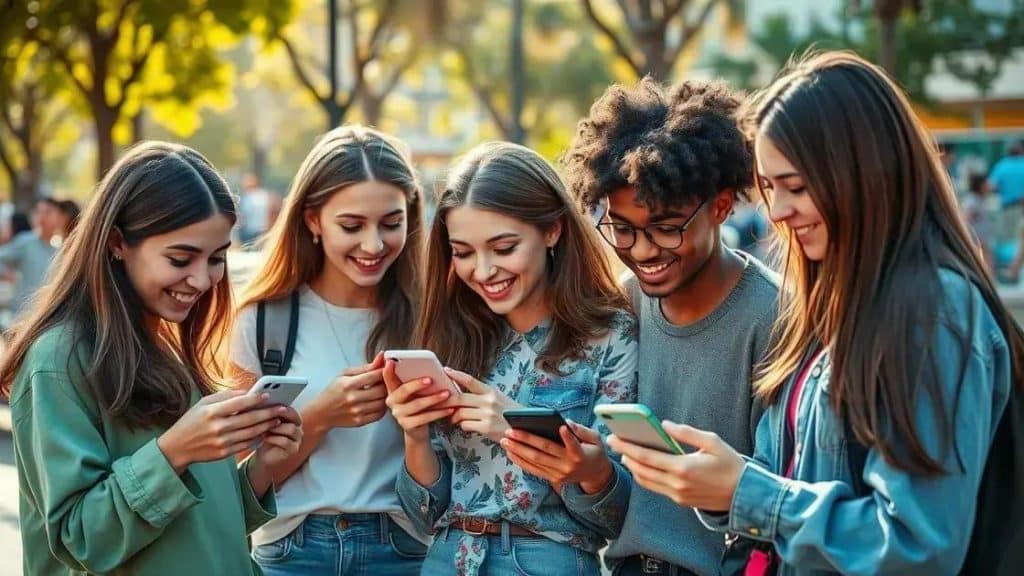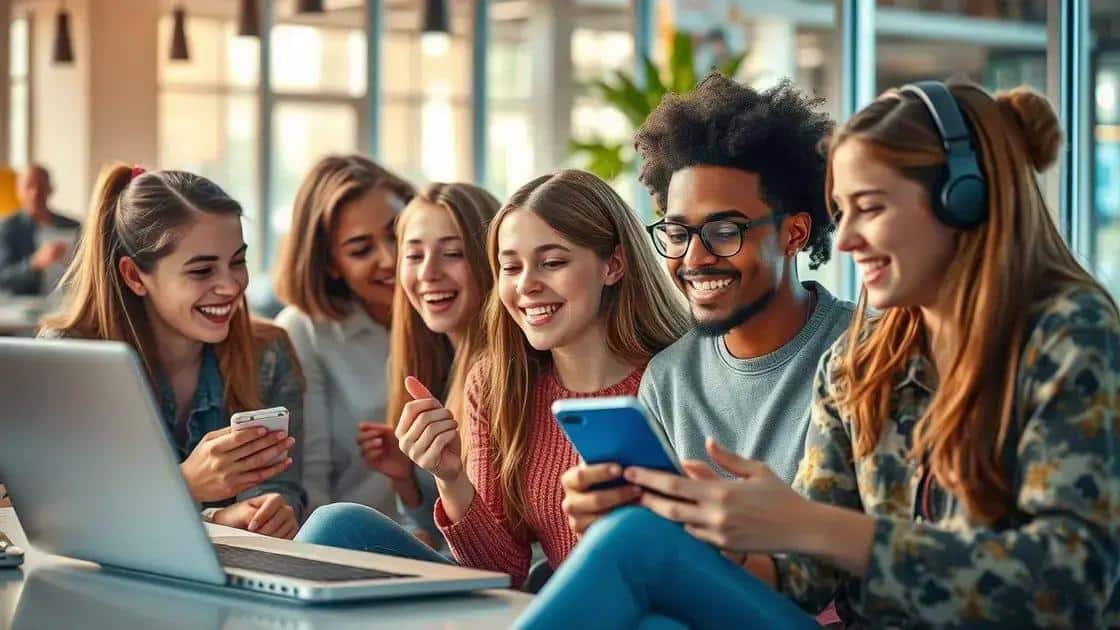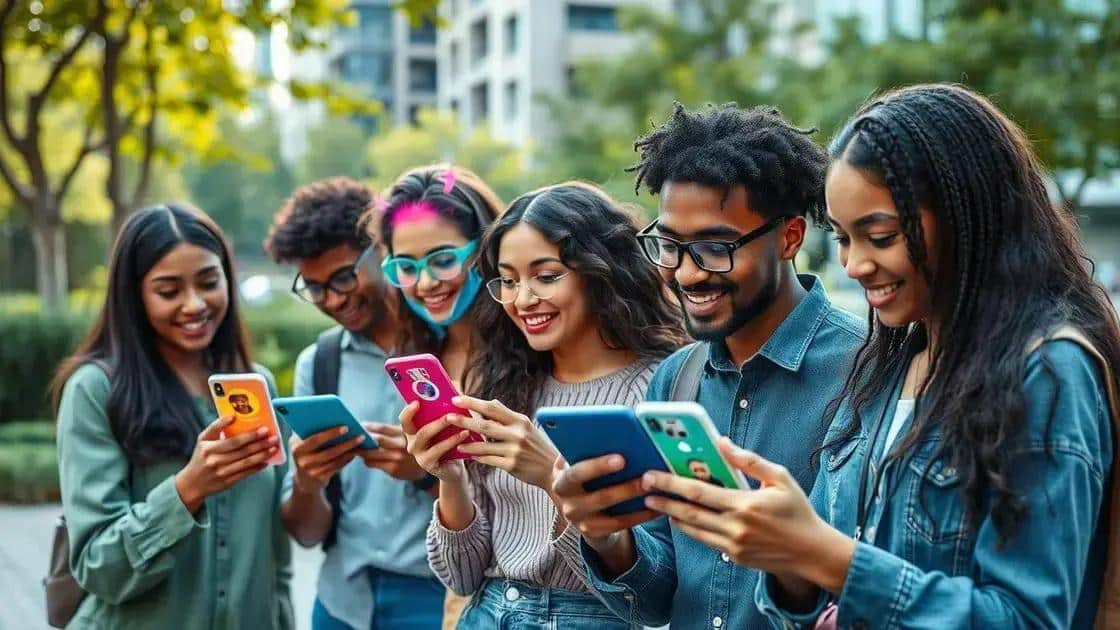Impact of social media on youth culture: a closer look

The impact of social media on youth culture is profound, influencing communication, creativity, and community-building while also posing risks such as cyberbullying and privacy concerns.
The impact of social media on youth culture is profound, shaping how young people connect and express themselves. Have you noticed how platforms like Instagram or TikTok influence trends and friendships? Let’s explore this dynamic.
Defining social media’s role in youth culture
Social media plays an essential role in shaping today’s youth culture. These platforms are not just for sharing photos; they are places where young people connect, learn, and express their identities. Understanding how social media affects their lives is crucial.
Understanding Social Media
At its core, social media offers a unique avenue for communication. It allows for instant sharing of thoughts and experiences. Young users rely on social media for everything from entertainment to political activism. This immediacy can both empower and challenge them.
Influence on Trends
Trends often spark from what is shared on these platforms. They propel everything from fashion choices to memes. Here are some key factors that illustrate the influence of social media on youth:
- Viral Challenges: Trends often emerge as challenges, encouraging youth to participate and share.
- Celebrity Influence: Public figures impact cultural norms through their online presence.
- Content Creation: The rise of influencers shows how youth can become trendsetters.
- Community Building: Social media fosters a sense of belonging among young people with shared interests.
This fluid exchange of ideas contributes to the dynamic nature of youth culture. Platforms allow for creativity and the sharing of diverse perspectives. However, this can lead to both positive and negative outcomes.
Moreover, as youth engage online, they develop unique identities and ways of communication. It has become common for young people to curate their online personae, which can differ significantly from their offline selves. This duality affects their self-image and personal relationships.
In conclusion, defining social media’s role in youth culture is multifaceted. It influences how young people interact, express themselves, and embrace trends. By navigating its advantages and challenges, youth can shape a vibrant cultural landscape that reflects their values.
Positive effects of social media on young people

Social media has several positive effects on young people, significantly impacting their social interactions and self-expression. These platforms provide a unique space where youth can connect with others, share their thoughts, and explore their interests.
Enhancing Communication Skills
One of the most notable benefits is the enhancement of communication skills. Young people learn to express their ideas through various formats, such as videos, images, and text posts. This practice helps them become more articulate and confident in their interactions both online and offline.
Building Communities
Social media allows users to find communities that share similar interests. This can create a sense of belonging and support.
- Shared Interests: Young users can connect with peers who share hobbies and passions, fostering friendships.
- Support Networks: Platforms can serve as a support system during tough times, providing resources and encouragement.
- Awareness Campaigns: Youth can engage in social issues, raising awareness about important topics that resonate with them.
Another positive aspect is the opportunity for creativity. Social media encourages creativity by allowing young people to showcase their artistic skills, be it through photography, art, or writing. This expression can not only be fulfilling but can also lead to new opportunities, such as scholarships and career paths.
Additionally, youth have the chance to develop digital literacy. Understanding how to navigate online platforms is crucial in today’s tech-driven world. Social media helps them learn how to communicate effectively, discern reputable information, and engage with diverse cultures. Learning these skills early on prepares them for future educational and career opportunities.
Engaging with content from different backgrounds can broaden young people’s perspectives, promoting empathy and understanding. They can learn about global issues and cultural differences, nurturing a more inclusive worldview. In summary, while social media has its challenges, the positive effects for young people are significant and transformative.
Negative influences and risks of social media
While social media offers various benefits, it also comes with significant negative influences and risks for young people. Understanding these dangers is crucial for navigating the digital world safely.
Cyberbullying and Harassment
One of the most alarming issues is cyberbullying. Online harassment can have severe emotional effects on young individuals. Many teens experience bullying through posts, comments, or direct messages. It can lead to feelings of isolation and anxiety. Here are critical points to consider:
- Erosion of Self-Esteem: Constant negative feedback can damage self-image.
- Social Isolation: Victims may withdraw from friends and family, deepening loneliness.
- Mental Health Issues: Increased risk of depression, anxiety, and suicidal thoughts can occur.
Furthermore, social media can expose youth to inappropriate content. With just a few clicks, they might encounter violence, explicit images, or harmful behaviors. This exposure can distort young minds and normalize unhealthy standards.
Privacy Concerns
Privacy is another significant risk. Many young users are unaware of how much personal information they share online. Over-sharing can lead to privacy breaches and even identity theft:
- Location Sharing: Posting location can make youth vulnerable to predators.
- Data Exploitation: Companies often exploit personal data for marketing, raising ethical concerns.
- Permanent Digital Footprint: Mistakes made online can resurface later, affecting future opportunities.
This vulnerability can create long-term repercussions, affecting both personal and professional aspects of life. Moreover, addiction to social media can occur as users seek validation through likes and comments. This dependence may lead to neglect of real-life relationships and responsibilities.
As youth focus on their online lives, they may miss out on important face-to-face interactions, impacting their social skills. Healthy boundaries are essential to mitigate these risks. Parents and guardians can help by encouraging open conversations about online behavior and teaching young people about the importance of safety and privacy.
Future trends in social media and youth engagement

The landscape of social media is constantly evolving, and future trends will significantly impact youth engagement. As technology advances, platforms are adapting to meet the needs and preferences of young users.
Rise of New Platforms
New social media platforms are emerging, creating fresh avenues for youth interaction. This shift allows young people to connect in unique ways. Platforms that focus on creativity and short, engaging content are gaining popularity. Here are some trends to watch:
- Short-Form Video Content: Platforms like TikTok have revolutionized how young people share and consume media.
- Augmented Reality (AR): AR features are becoming popular, allowing users to engage with content in immersive ways.
- Focus on Privacy: As awareness grows, platforms are implementing better privacy controls catering to younger users.
Youth are also becoming more selective about the platforms they use. They prefer spaces that prioritize creative expression and authenticity, steering away from environments perceived as toxic.
Increased Activism and Awareness
Another trend is the rise in youth activism. Social media empowers young people to voice their opinions and engage with societal issues. This engagement is leading to:
- Real-World Impact: Online movements often translate into in-person advocacy and change.
- Collaborative Campaigns: Youth are joining forces across platforms to launch campaigns on pressing global issues.
- Awareness of Misinformation: Young users are becoming savvy at identifying credible sources and advocating for accurate information.
As digital citizenship becomes more crucial, educational initiatives are starting to focus on teaching young users responsible social media engagement. User-generated content will continue to shape discussions and trends, allowing youth to influence their culture actively.
With the integration of advanced technology such as artificial intelligence, platforms may offer personalized content curation and enhance user experience. This will change how young people interact, making engagement more relevant and meaningful.
FAQ – Questions About the Impact of Social Media on Youth Culture
What are the positive effects of social media on youth?
Social media enhances communication skills, helps build communities, and allows for creative expression, empowering young people to connect with others.
What risks are associated with social media usage for young individuals?
Risks include cyberbullying, privacy concerns, and exposure to inappropriate content, which can negatively affect mental health.
How can youth engage responsibly on social media?
Young users should be aware of their online behaviors, practice cautious sharing, and seek to understand the implications of their digital footprints.
What trends are shaping the future of youth engagement on social media?
Emerging trends include short-form video content, increased activism, and the rise of new platforms that prioritize user privacy and creativity.





